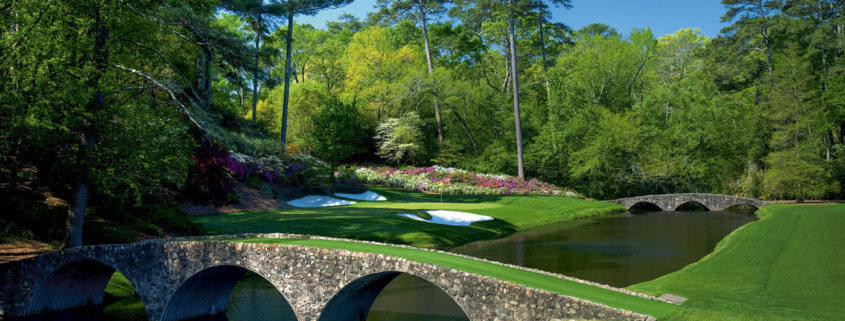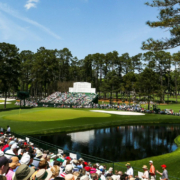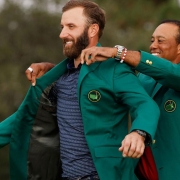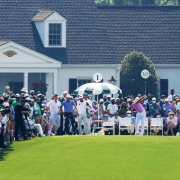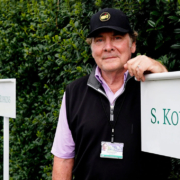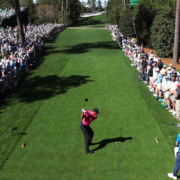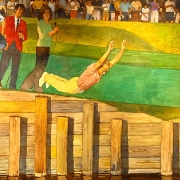A Walk at The Masters
I took a walk today. That’s not unusual and this particular walk is one I’ve made perhaps two hundred times before. But this was a special version of that walk. Whenever I get to Augusta National, I take part of the first day I’m there to walk the back nine. And it’s the same walk every time.
Starting just behind the scoreboard to the right of the first fairway, I walk up the hill toward the first tee and just on the outskirts of the famous oak tree that sits behind the clubhouse. The walk starts here each year because that’s where the press room used to be. A Quonset hut full of the legends of sports journalism before the explosion of media, that press room had a manual scoreboard at the front. It was replaced by the first permanent Press Building, but on the same spot. And now, the golf cart shuttle from the magnificent new Press Building drops you in that same spot.
The hill walking up next to the golf shop is usually worn with patron pedestrian traffic. But on this walk it was lush and green. And I was the only person there. The first fairway was open, no ropes, just small dark green dashes on the ground, a reminder of where to, and where not to walk. The walkway was marked by a couple of stakes on the ground but only a few maintenance cart tire tracks had passed that way.
Each time I walk by the golf shop, I have the same thought, about a story Jack Nicklaus told me. Chatting during construction of The King and The Bear course at World Golf Village, we were talking about the changes at Augusta in the era before they announced what they were doing to the golf course in the off season. Jack said after one of his wins, the following year he walked out of the golf shop, headed to the first tee. As with most courses of that era, the first tee was right outside the door. Jack’s play had made the game longer as Bobby Jones said, “he plays a game I’m not familiar with.” Nicklaus held his hands out in front of him, palms facing each other and in a very animated voice said, “But it wasn’t there, it was up there,” as he gestured and looked to his left. Going by the shop, I glanced to my right, looking for any hint of a former tee, but none to be found.
At the top of the hill, I was struck by how still it was. Just some security standing around, nothing going on under the oak tree, the first tee open without any restrictions. I walked around the back of the tee and marveled at how close it was to the practice green that sits outside the clubhouse. That used to be a huge meeting place for patrons. The lengthening of the first hole has made that just a walkway.
This walk always turns right and heads down the right side of the tenth hole. The tenth tee was open, a few players were finishing on eighteen to my right. I stopped as one of them prepared to play a shot out of the right bunker on eighteen. It occurred to me that side of the hill is usually full of fans in a ‘sitting only’ area. Stopping during a practice round on this walk usually isn’t necessary. Patrons are usually streaming to and from the back nine. But I was the only spectator there. The only person not a part of the game. So, stopping just seemed the right golf etiquette. A nearly perfect bunker shot ensued, settling about two feet from the back-pin position.
One of the things television can’t convey from Augusta National is the elevation changes on the golf course. Walking down next to the tenth fairway, you could almost call it steep. Ten is so directly downhill, that as a par four, it’s actually longer in yardage than the par five thirteenth. Halfway down the hill I had a bit of a wry smile, thinking I might not have been able to make this walk if the tournament was held as scheduled in April. Left hip replacement last November has been very successful but I’m still working on regaining the muscle strength in my left leg. I still struggle a bit downhill, but I’m not sure I’d have gotten even this far eight months ago.
By now, I was virtually alone. I glanced to my right as a passed by the spot Bubba Watson hit that hook out of the woods to win in a playoff. A few hole monitors were just about to gather their things and finish their days work. We exchanged hellos and I stopped for a second when one asked me how I was doing. “Couldn’t be better,” I said. “I’m here.” “That’s true,” he answered, “Couldn’t be better.” I heard tee shots being hit in the distance on fifteen.
A couple of carts went by me as I crested the hill to the right of ten green and just to the side of the fifteenth tee. When I take this walk with somebody attending the Masters for the first time, at this point I usually take them around the back of ten and back up the little hill behind the eleventh tee. They’ve moved that tee back in the last ten years, adding yardage to the hole. It’s a demanding tee shot out of that chute, especially since they added the trees to the right of the fairway. That’s one of my favorite spots in practice rounds or during the tournament. There aren’t many people back there, and the players walk right up and occasionally have to wait on their tee shots. Sometimes they’ll chat up the fans, it’s a little bit of a relaxed moment in an otherwise focused eighteen holes. In the era of persimmon head drivers, the echo through the tall pines of the crack of the club hitting the ball is the most unique, and satisfying golf sound I’ve ever heard.
When the TV station I worked for was the CBS affiliate, I used to scoot to the other side of the eleventh tee and take the short walk up the tree-lined cinder roadway to the television compound. I knew most of the CBS production crew and the announcers, mainly thanks to my friendship with Pat Summerall. I’d spend time in Frank Chirkinian’s office listening to golf stories, mostly told by his “do everything” producer Chuck Will.
But not today.
Heading down right of the eleventh fairway I was very aware that I was alone. Nobody in sight. Nobody playing number eleven. Nobody on fifteen tee. Nobody on fourteen green. No players, no officials, no workers. I walked around the closed concession stand to Amen Corner, by myself, noticing there were no stands erected there, and still, nobody in sight.
Earlier in the week, Dottie Pepper, part of the CBS announce crew said she walked down to Amen Corner on Monday and was struck by how quiet it was. Jim Nantz takes that same walk every Wednesday afternoon when the Par 3 tournament is going on to immerse himself in the moment before his broadcast duties begin. Standing there, I thought about what Jim had said Monday, explaining the gratitude he feels every time he takes that walk.
In that setting, I’m not sure I can exactly describe what was running through my mind. A few birds were chirping. I could hear the soft whine of a water pump behind the eleventh green. The distant staccato of mowers cutting grass at Augusta Country Club behind the thirteenth tee was faint in the background. The occasional passenger and private jet executed their climb out just east of The National, only noticeable against the silence.
I thought about walking off a few times, but there, by myself, I looked around in a circle, cataloguing some of my experiences in that spot. Up the hill is where one of the first photographers I worked with, Ramon Hernandez and I watched a lot of golf early in my career. My wife Linda and I walked all eighteen holes a few years ago and I’m pretty sure right where I was standing was her favorite spot. Just down the hill a few steps is where my colleague Tom Wills and I watched action on the twelfth green at the 1985 tournament. Rob Kearney and I always position ourselves in front of the stands, as we’re just tall enough to see over the patrons and onto the twelfth tee. Matt Robinson and I had a head-shaking, eyebrow raising chuckle standing on the twelfth tee the year we played there together. One of those, “How’d we get here?” silent laughs.
Over toward the thirteenth fairway is where my friend Todd Galley got down on one knee and proposed to his now wife Dierdre. My long-time producer, photographer, friend and confidant Matt Kingston liked this spot the best. And I smiled thinking of all the times I stood in this spot with Kevin Talley, my most-often companion at Augusta National and the Masters. I met Kevin at the Masters while he was working with Warren Peper at Channel 5 in Charleston and hired him to come to Jacksonville in 1990. As a professional television producer and photographer, we traveled the US (and the UK), working together with a close friendship, but I never saw him happier than when we were standing in that spot at Augusta National. We’d get there, he’d pull out a cigarette and say, “It’s time for a smoke.” I’d tell him every year it was sacrilegious to smoke in that spot, until I realized it was one of his traditions at The Masters. And in my first trip to The Masters in 1979, I took my Dad as my photographer (there was no such person at the station I worked for that year in Charleston) and we smoked a cigar together in that spot. Still alone, the occasional light breeze going by, I felt that sense of gratitude that comes from remembering shared experiences with people you’re close to.
Walking up the right of the thirteenth fairway I paused to look at the green in the distance. Normally framed by a splash of azaleas, some of the deciduous trees in the background had begun to change color, adding a hint of autumn to the scene.
To the right is where my brother Gust and I waited for Fred Couples beside the fourteenth fairway before he hit his second shot in a practice round. I know Freddie pretty well, but he and my brother are actual friends. It was fun to see he and his then-caddie Joey LaCava light up and come over to chat when they heard my brother’s voice.
Crossing the fourteenth fairway on an unused walkway, I paused in the middle to see the golfer’s perspective of that hole. I’ve been fortunate to play Augusta National a few times and I thought about the mix of emotions I’ve had every time I’ve teed it up there. Excitement and fear with a healthy dose of humility, knowing I can’t replicate the shots I’ve seen there by the best players in the world.
Up to the fifteenth fairway and still alone, I looked down at the amphitheater formed by the fifteenth green, the sixteenth, and the seventeenth tee. With nobody there.
Around the seventh green, the eighth tee and behind the seventeenth green, I walked over to see the tee shot on eighteen. Intimidating to say the least, it would be hard to capture in any medium how narrow the chute is on the tee shot is trying to carve it up the hill on the finishing hole. Freddie always says, “Aim down the middle with a little cut on it and hit it hard.”
Back down to the right of the eighth tee, the walk up the left of eighteen doesn’t flatten out until you get to the clubhouse. I stood by the fairway bunkers in the eighteenth fairway and didn’t recognize the trees that were beyond the bunkers, left of the fairway. Were they new? They look like they’d been there a hundred years. Hitting it over or left of the bunkers now will be no picnic for the second shot.
By now there was a soft rain falling and a few umbrellas were opening at the top of the hill. A half-dozen greenskeepers were putting the finishing touches on the ninth green in the fading light
Back around the first tee, another feature of The Masters was still intact. As I passed each security guard, they greeted me with a polite hello or gesture of recognition. I’ve always liked that. . Call it Southern Hospitality if you like, but it always seems right to me.
Only members and officials are allowed in the clubhouse this year, so one of my personal favorite Masters traditions will have to wait. At this point in the walk, I usually head into the clubhouse grill and walk to the end of the bar. For thirty years, “Coach” was on station there, and unfailingly would remember, “Vodka, lemonade?” when I’d ask how he’d been. When he retired, his son was there for a few years and we followed the same routine.
Lingering under the oak tree after the walk I’d renew old acquaintances each year, see some of the celebrities in attendance and generally watch the world go by. Occasionally, I’d smoke a cigar, away from the crowd, people watching. About five years ago a gentleman politely came and stood next to me, also a casual observer. I said hello, and he nodded, eyeing my cigar. I asked if he’d like one, (don’t ever smoke in public without an extra in your pocket) and realized quickly we had a language barrier. Looking at his badge, he was a representative of the Argentina Golf Federation and was here as a guest of the tournament. Miguel spoke no English and I only have a version of ‘restaurant Spanish’ I can muster but somehow, we figured out how to have a whole conversation, without saying much, around two cigars and golf. The next year, I was standing in the same spot, not smoking, people watching, when I had a tap on my shoulder. Miguel was standing beside me, two cigars in hand, smiling.
Only at The Masters.

